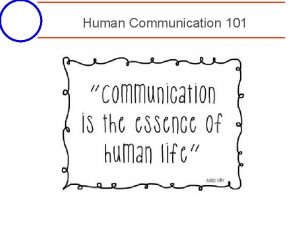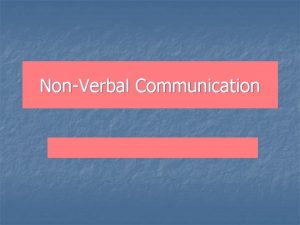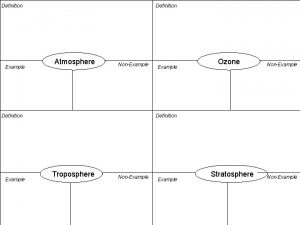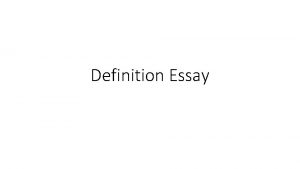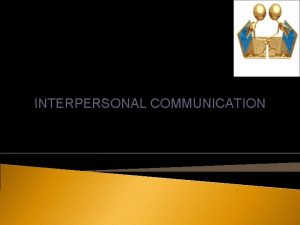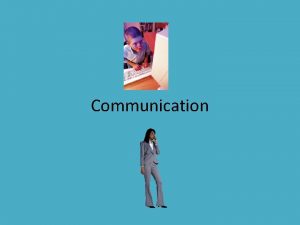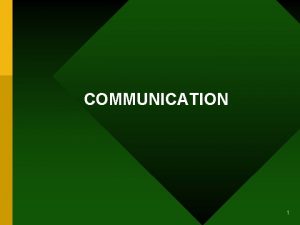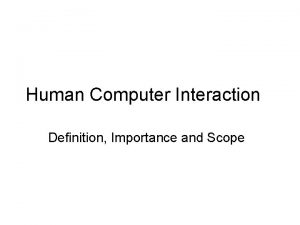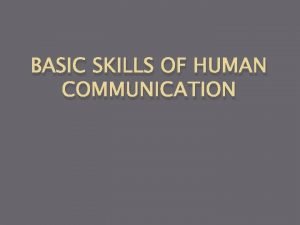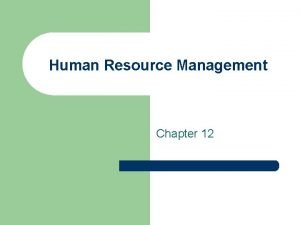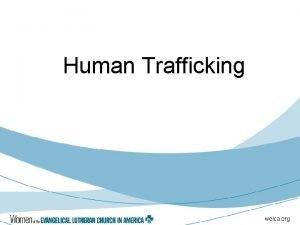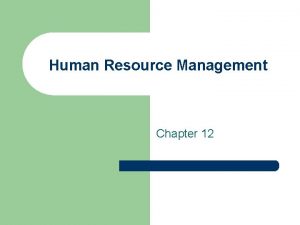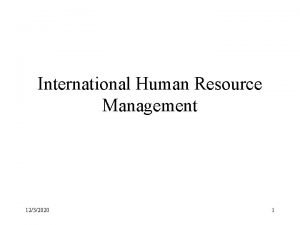COMMUNICATION 1 Definition Communication Human communication is the























- Slides: 23

COMMUNICATION 1

Definition: Communication Human communication is the process of creating meaning between two or more people, which can occur in a variety of situation. This situation can be placed in five broad categories to focus the analysis of human communication. • Definition: Communication – Transfer of information: from one person to another, from one group or organization to another, using interpersonal or mass media channels – Expansion of understanding: participants in the communication process create and share information with one another in order to reach a mutual understanding. 2 – Convergence and action

• Definition: Behaviour Change Communication – BCC is a multi-level tool for promoting and sustaining risk-reducing behaviour change in individuals and communities by distributing tailored health messages in a variety of communication channels. • Definition: Behaviour – Action of an individual, group, or community that can range from: • Expressed intention to engage in an activity • Actual trial of the expressed intention • Continued behaviour, such that this becomes practice 3

4

Behavioural Model Why? They don’t do We must under- stand why by using research to: Determine program strengths, weaknesses, opportunities, and threats Determine community health situation Determine specific audience health perceptions, behaviours, needs Then So that We provide a program that features: They do Services, products, features that people want Easy access to what they need Information they understand From sources they trust 5

Communication stages • Stage 1: reaching the intended audience – Communication can not be effective unless it is seen or heard by its intended audience. – This may seem obvious and does not require any complex theories to explain. – But many programmes fail even at this simple stage. – A common cause of failure is reaching the wrong target. 6

• Stage 2: attracting the audience's attention – Any communication must attract attention so that people will make the effort to listen and or read it. The failures of this stage communication are: – walking past the poster without bothering to look at it, – not paying attention to the health talk or demonstration at the clinic, – not stopping at the exhibition at the showground, and – Turning off radio program or switching over. 7

• Stage 3: understanding the message, – Once a person pay attention to the message she/he then tries to understand it. – Another name for this stage is perception. – Visual perception is the term used for understanding the visual messages and pictorial perception for understanding of pictures. – Perception is a highly subjective process – two people may hear the same radio programme or see the same poster and interpret the message quite differently from each other and from the meaning intended by the sender. 8

• Stage 4: promoting change, – A communication should not only be received and understood – – it should be believed and accepted. But changing beliefs is not always easy. – It is easier to change beliefs when they have been acquired only recently. – It is more difficult to influence a belief that has been held for a long time or if people already have well-developed beliefs on the topic. 9

• Stage 5: producing a change in behaviour, – A communication may result in a change in beliefs and attitude but still not influence behaviour. – This can happen when the communication has not been targeted at the belief that has the most influence on the person's attitude to the behaviour. • For instance: many programs have emphasized the dangers of diarrhea and failed to give enough emphasis to dehydration. – A person may have a favorable attitude and want to carry out the action. However, pressure from other people in the family or community may prevent the person from doing it. – Another reason, a person may not perform a behaviour is a lack of enabling factors such as money, time, skills or health services. 10

• Stage 6: improvement in health – Improvement in health will only take place if the behaviours have been carefully selected so that they really influence health. – If your messages are based on outdated and incorrect ideas, people could follow your advice but their health would not improve. 11

Components of communication MESSAGE Advice Non-verbal Wording Pictures Appeals CHANNEL Radio and TV Newspapers Leaflet One-to-one Small group Drama and song RECEIVER Education Visual literacy Media habits Culture Interests Age and sex 12

• Developing Communication Skills – Verbal communication – Nonverbal Communication • Communication types – One-way communication – Two-way communication 13

Main characteristics of mass media and face to face channels Characteristic Mass media Face to face Speed to cover large population Rapid Slow Accuracy and lack of distortion High accuracy Easily distinguished Ability to select particular audience Difficult to select Audience Can be highly selective Direction One-way Two-way Ability to respond to local needs of specific communities Only provides nonspecific information Can fit to local need Feedback Only indirect feedback Direct feedback possible from surveys Main effect Increased awareness Changes in attitudes and behaviours, problem 14 solving skills

15

Communication messages • The message consists of what is actually communicated including the actual appeals, words, pictures and sounds that you use to get the ideas across. 16

Factors Influencing Communication • People's reactions to the new information are influenced by how, where and from whom they receive it. These factors can mean the difference in whether or not people act on the information. People are more likely to trust information and act on it if: • They hear it repeatedly from many resources, • The person delivering it is well known and trusted • They understand how it can help their families • It is communicated in familiar language • They are encouraged to discuss it and to ask questions to clarify their understanding of what needs to be done, when and why. 17

The nature of the advice given • A message will only be effective if the advice presented is relevant, appropriate, acceptable, and put across in an understandable way. • In deciding what advice to give, you will need to apply both an understanding of health and disease as well as the various influences on behaviour. 18

19

Health Communication Breakdown 1. Messages may reach only some of intended target audience because the communication channels were not effective. • Solution: If possible, use a combination of mass media to inform the audience and face to face communication to reinforce the message. Conduct participatory research to find out what communication channels are most likely to reach and have credibility with the audience. 2. People may receive the message but not understand it • Solution: When translating or adapting the messages, use simple, non-technical language. Pre-test the messages to check if the intended audiences 20 understand them.

3. People may receive the message but misinterpret it and apply it incorrectly • Solution: Repeat information to reinforce it. If any new skills are required, provide adequate training and follow-up periodically to identify and correct any problems by offering additional support or revising the message. 21

4. People may receive and understand the information but not act on it because it conflicts with existing attitudes and beliefs • Solution: Prepare messages that dispel harmful myths in a culturally sensitive way 5. People may receive and understand the new information but be unable to act on it because of various reasons, such as poverty, or because basic services are not available • Solution: Liaise with local health authorities before undertaking media campaigns to ensure that the recommended services or products are available and affordable. 22

Reference: • 1. Hubley John, (1993), Communicating in Health, An action guide to health education and health promotion. • 2. Payne. A. Wayne. & Hahn. B. Dale, (2, 000), Six Edition, Understanding your health, ISBN 0 -07 -039235 -8. • 3. Severin, J. Werner & Tankard, W. James, (2001), Communication Theories, Origins, Methods, and Uses in the Mass Media. • 4. Torres, Rosalie; Preskill, Hallie & Piontek, (1999), Evaluation Strategies for Communicating and Reporting, Enhancing Learning in Organizations, • 5. UNICEF, UNFPA, UNDP, UNAIDS, WFP, & WB, 2002, Fact for Life, Third Edition, • 6. WHO, 1988, Health Education for Health, A manual on health education in Primary Health Care, World Health Organization, Geneva, Printed in England. 23
 Human development index definition ap human geography
Human development index definition ap human geography Hình ảnh bộ gõ cơ thể búng tay
Hình ảnh bộ gõ cơ thể búng tay Lp html
Lp html Bổ thể
Bổ thể Tỉ lệ cơ thể trẻ em
Tỉ lệ cơ thể trẻ em Gấu đi như thế nào
Gấu đi như thế nào Tư thế worm breton
Tư thế worm breton Chúa yêu trần thế alleluia
Chúa yêu trần thế alleluia Các môn thể thao bắt đầu bằng tiếng đua
Các môn thể thao bắt đầu bằng tiếng đua Thế nào là hệ số cao nhất
Thế nào là hệ số cao nhất Các châu lục và đại dương trên thế giới
Các châu lục và đại dương trên thế giới Công thức tính độ biến thiên đông lượng
Công thức tính độ biến thiên đông lượng Trời xanh đây là của chúng ta thể thơ
Trời xanh đây là của chúng ta thể thơ Mật thư anh em như thể tay chân
Mật thư anh em như thể tay chân Làm thế nào để 102-1=99
Làm thế nào để 102-1=99 độ dài liên kết
độ dài liên kết Các châu lục và đại dương trên thế giới
Các châu lục và đại dương trên thế giới Thơ thất ngôn tứ tuyệt đường luật
Thơ thất ngôn tứ tuyệt đường luật Quá trình desamine hóa có thể tạo ra
Quá trình desamine hóa có thể tạo ra Một số thể thơ truyền thống
Một số thể thơ truyền thống Bàn tay mà dây bẩn
Bàn tay mà dây bẩn Vẽ hình chiếu vuông góc của vật thể sau
Vẽ hình chiếu vuông góc của vật thể sau Nguyên nhân của sự mỏi cơ sinh 8
Nguyên nhân của sự mỏi cơ sinh 8 đặc điểm cơ thể của người tối cổ
đặc điểm cơ thể của người tối cổ
























